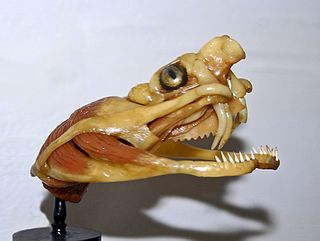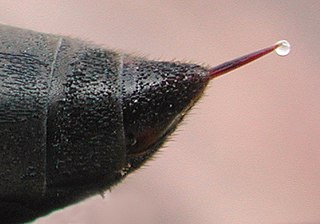Related Research Articles

Lachesis is a genus of venomous pit vipers in the family Viperidae. Member species are found in forested areas of the Neotropics. The generic name refers to one of the Three Fates, Lachesis, who determined the length of the thread of life. Four species are currently recognized as being valid.

Rattlesnakes are venomous snakes that form the genera Crotalus and Sistrurus of the subfamily Crotalinae. All rattlesnakes are vipers. Rattlesnakes are predators that live in a wide array of habitats, hunting small animals such as birds and rodents.

The Viperidae (vipers) are a family of snakes found in most parts of the world, except for Antarctica, Australia, Hawaii, Madagascar, New Zealand, and various other isolated islands. They are venomous and have long, hinged fangs that permit deep penetration and injection of their venom. Three subfamilies are currently recognized. They are also known as viperids. The name "viper" is derived from the Latin word vipera, -ae, also meaning viper, possibly from vivus ("living") and parere, referring to the trait viviparity common in vipers like most of the species of Boidae.

Crotalus is a genus of venomous pit vipers in the family Viperidae, commonly known as rattlesnakes or rattlers. The genus is found only in the Americas from southern Canada to northern Argentina. The generic name Crotalus is derived from the Greek word κρόταλονkrótalοn, which means "rattle" or "castanet", and refers to the rattle on the end of the tail, which makes this group so distinctive. As of July 2023, 44 to 53 species are recognized as being valid.

Snake venom is a highly toxic saliva containing zootoxins that facilitates in the immobilization and digestion of prey. This also provides defense against threats. Snake venom is injected by unique fangs during a bite, whereas some species are also able to spit venom.

Envenomation is the process by which venom is injected by the bite or sting of a venomous animal.

Crotalus scutulatus is a highly venomous pit viper species found in the deserts of the southwestern United States and central Mexico. It is perhaps best known for its potent neurotoxic-hemotoxic venom, which is considered the world's most potent rattlesnake venom.

The eastern diamondback rattlesnake is a species of pit viper in the family Viperidae. The species is endemic to the Southeastern United States. It is one of the heaviest venomous snakes in the Americas and the largest rattlesnake. No subspecies are recognized.
Crotalidae Polyvalent Immune Fab (ovine), sold under the brandname CroFab, is a snake antivenin, indicated for North American Crotalid (Rattlesnake, Copperhead and Cottonmouth/Water moccasin) snake envenomation.

Myotoxins are small, basic peptides found in snake venoms and lizard venoms. This involves a non-enzymatic mechanism that leads to severe muscle necrosis. These peptides act very quickly, causing instantaneous paralysis to prevent prey from escaping and eventually death due to diaphragmatic paralysis.

The western diamondback rattlesnake or Texas diamond-back is a rattlesnake species and member of the viper family, found in the southwestern United States and Mexico. Like all other rattlesnakes and all other vipers, it is venomous. It is likely responsible for the majority of snakebite fatalities in northern Mexico and the greatest number of snakebites in the U.S. No subspecies are currently recognized.
Adamalysin is an enzyme. This enzyme catalyses the following chemical reaction
Atrolysin A is an enzyme that is one of six hemorrhagic toxins found in the venom of western diamondback rattlesnake. This endopeptidase has a length of 419 amino acid residues. The metalloproteinase disintegrin-like domain and the cysteine-rich domain of the enzyme are responsible for the enzyme's hemorrhagic effects on organisms via inhibition of platelet aggregation.
Leucolysin is an enzyme. This enzyme catalyses the following chemical reaction
Atrolysin B is an enzyme. This enzyme catalyses the following chemical reaction
Atrolysin C is an enzyme. This enzyme catalyses the following chemical reaction
Atrolysin E is an enzyme. This enzyme catalyses the following chemical reaction
Atrolysin F is an enzyme. This enzyme catalyses the following chemical reaction
Horrilysin is an enzyme. This enzyme catalyses the following chemical reaction
Ruberlysin is an enzyme. This enzyme catalyses the following chemical reaction
References
- ↑ Willis TW, Tu AT (June 1988). "Purification and biochemical characterization of atroxase, a nonhemorrhagic fibrinolytic protease from western diamondback rattlesnake venom". Biochemistry. 27 (13): 4769–77. doi:10.1021/bi00413a028. PMID 3167016.